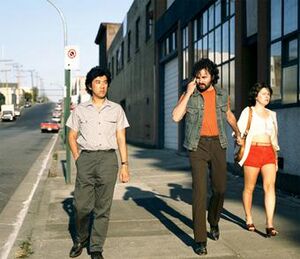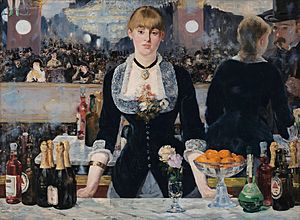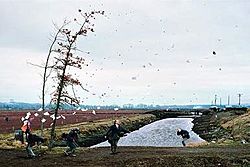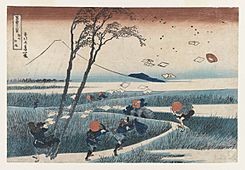Jeff Wall facts for kids
Quick facts for kids
Jeff Wall
OC RSA
|
|
|---|---|
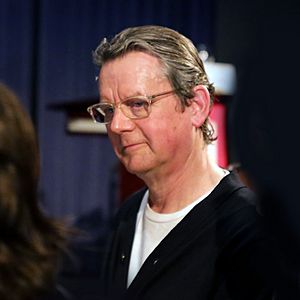
Jeff Wall at Paris Photo 2014
|
|
| Born |
Jeffrey Wall
September 29, 1946 Vancouver, British Columbia, Canada
|
| Alma mater | University of British Columbia Courtauld Institute of Art |
| Known for | Photographer |
|
Notable work
|
Picture for Women (1979) Mimic (1982) A Sudden Gust of Wind (after Hokusai) (1993) |
| Movement | Vancouver School |
| Awards | Hasselblad Award (2002) |
Jeffrey Wall (born September 29, 1946) is a famous Canadian photographer. He is known for his very large photographs that are lit from behind, like big light-up signs. These photos are often called Cibachrome transparencies. Early in his career, he helped start a group of artists called the Vancouver School. He has also written about the work of other artists from Vancouver. His photos often show scenes from Vancouver, mixing its natural beauty with city life and industrial areas.
Contents
Jeff Wall's Career
Jeff Wall studied at the University of British Columbia and later at the Courtauld Institute of Art in London. After finishing his studies, he taught art at different universities. He was a professor at the University of British Columbia until he retired in 1999. Wall has written many essays about other artists. He also talks a lot about his own work and the ideas behind it.
How Jeff Wall Makes Art
Jeff Wall started making art again in 1977. This is when he began creating his special backlit photo-transparencies. Many of his photos are carefully set up, like scenes in a movie. They often refer to famous artworks or ideas from history and philosophy. For example, his pictures might remind you of paintings by artists like Diego Velázquez or Édouard Manet. They can also be inspired by writers like Franz Kafka.
Wall's art from the late 1970s explored ideas about how things look like they are on a stage. He was inspired by television, advertisements, and store window displays. In 1978, he showed his first gallery exhibition as an "installation." He put his photo The Destroyed Room in a storefront window.
Famous Photographs
Mimic (1982) is a good example of Wall's movie-like style. It's a large color photo, about 6.5 feet by 7.5 feet. It shows a white couple and an Asian man walking on a sidewalk. The background looks like a North American suburb with parked cars and buildings. The photo seems like a quick, unplanned shot, but Wall actually recreated a moment he saw in real life. The boyfriend in the photo makes a rude gesture towards the Asian man. This picture shows social tensions in a very clear way.
Picture for Women (1979) is another important photo by Wall. It's a large color transparency mounted on a lightbox. Wall believes this photo, along with The Destroyed Room, helped him create a new style of photography. The Tate Modern museum says that this photo connects to both popular culture, like bright cinema signs, and the grand scale of classical paintings. Because they are lit up and large, Wall's lightboxes feel like sculptures.
In Picture for Women, you can see two people: Wall himself and a woman looking at the camera. Art critic Jed Perl calls Picture for Women Wall's most important work. It shows the artist in his studio in the late 20th century.
This photo is also a response to a famous painting by Manet called Un bar aux Folies Bergère.
In Manet's painting, a barmaid looks out, and a shadowy man watches her. The whole scene seems to be reflected in a mirror behind the bar. Wall uses a similar idea in his photo. The people in his picture are also reflected in a mirror. The woman looks like Manet's barmaid, and the man is Wall himself. Wall places the camera in the middle of his photo. This way, it shows the act of taking the picture (what's reflected in the mirror) and also looks straight out at us, the viewers.
Some of Wall's photos are very complex to make. They involve actors, special sets, and digital editing. They are like one-scene movies. For example, Dead Troops Talk (A Vision After an Ambush of a Red Army Patrol near Moqor, Afghanistan, Winter 1986) (1992) shows a made-up event. It was praised for its deep meaning and power.
In the early 1990s, Wall also started taking still life photos. He makes a difference between "documentary" pictures, which are not set up, and "cinematographic" pictures, which use actors, sets, and special effects. A Sudden Gust of Wind (after Hokusai) (1993) is a "cinematographic" picture. It is based on an old Japanese woodblock print by Katsushika Hokusai. Wall recreated the 19th-century scene in modern British Columbia using actors. It took over a year to make 100 photos to create one perfect image that looks like a real moment in time.
Since the early 1990s, Wall has used digital technology to combine different photos into one seamless image. His most famous works are large transparencies on light boxes. He got the idea for this format when he saw backlit advertisements at bus stops. In 1995, Wall also started making traditional black and white photos, which have become a big part of his work.
His work After "Invisible Man" by Ralph Ellison, the Prologue (1999–2000) shows a famous scene from Ralph Ellison's novel. Wall's photo shows the cellar room where the book's narrator lives, complete with 1,369 lightbulbs.
Exhibitions
Jeff Wall's art has been shown in many places around the world. His first solo show was in Vancouver in 1978. Since then, his work has been featured in major museums like the Tate Modern in London (2005) and the MoMA in New York (2007). He has also been part of important art events like documenta in Germany. In 2011, for a show in Brussels, Wall chose about 130 works by his favorite artists to be shown alongside 25 of his own pictures.
Awards and Recognition
Jeff Wall has received many awards for his photography:
- Hasselblad Award in 2002, which is a very important photography prize.
- He became a Fellow of the Royal Society of Canada in 2006.
- He was made an Officer of the Order of Canada in 2007.
- He won the Audain Prize for Lifetime Achievement in the Visual Arts in 2008.
Art critic Blake Gopnik included Wall in his 2011 list of "The 10 Most Important Artists of Today." Gopnik said that Wall has been exploring what pictures can still do and mean for three decades.
Influence on Other Artists
Jeff Wall's large-scale photos and carefully planned compositions have greatly influenced other photographers. He is seen as a major influence on the Düsseldorf School of Photography, which includes artists like Andreas Gursky. Gursky has even said that Wall was "a great model" for him.
See also
 In Spanish: Jeff Wall para niños
In Spanish: Jeff Wall para niños


